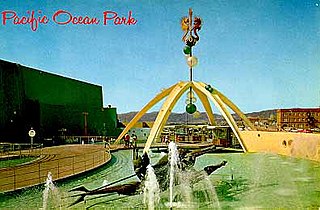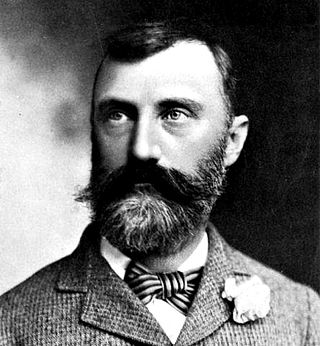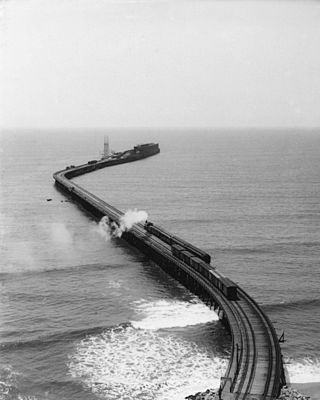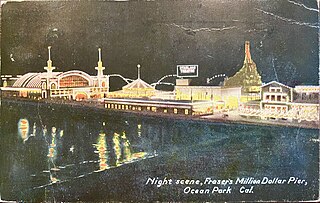
Santa Monica Bay is a bight of the Pacific Ocean in Southern California, United States. Its boundaries are slightly ambiguous, but it is generally considered to be the part of the Pacific within an imaginary line drawn between Point Dume, in Malibu, and the Palos Verdes Peninsula. Its eastern shore forms the western boundary of the Los Angeles Westside and South Bay regions. Although it was fed by the Los Angeles River until the river's catastrophic change of course in 1825, the only stream of any size now flowing into it is Ballona Creek. Smaller waterways draining into the bay include Malibu Creek, Topanga Creek, and Santa Monica Creek.

Pacific Ocean Park was a 28-acre (11-hectare) nautical-themed amusement park built on a pier at Pier Avenue in the Ocean Park section of Santa Monica, California in 1958. Intended to compete with Disneyland, it replaced Ocean Park Pier (1926–1956). After it closed and fell into disrepair, the park and pier anchored the Dogtown area of Santa Monica.

The Santa Monica Pier is a large pier at the foot of Colorado Avenue in Santa Monica, California, United States. It contains a small amusement park, concession stands, and areas for views and fishing. The pier is part of the greater Santa Monica Mountains National Recreation Area.
The history of Santa Monica, California, covers the significant events and movements in Santa Monica's past.

The Third Street Promenade is a pedestrian mall esplanade, shopping, dining and entertainment complex in the downtown area of Santa Monica, California which originally opened as the Santa Monica Mall on November 8, 1965. It is considered a premier shopping and dining district on the Westside and draws crowds from all over the Greater Los Angeles area. Due to easy access to Downtown Los Angeles via the Big Blue Bus rapid transit service, E Line's terminus station and the Pacific Coast Highway-Santa Monica Freeway Interstate, the neighborhood's north-south thoroughfares connecting to Muscle Beach, Venice Canal Historic District, Marina del Rey, Ballona Wetlands and Los Angeles International Airport, and its proximity to historic U.S. Route 66, Santa Monica Pier, Palisades Park, Tongva Park, Santa Monica State Beach and the Pacific Ocean coupled with Los Angeles's mild mediterranean climate, it is also a popular tourist destination.

The Marvin Braude Bike Trail is a 22-mile (35 km) paved bicycle path that runs mostly along the shoreline of Santa Monica Bay in Los Angeles County, California. The coastal bike trail is widely acknowledged as Los Angeles’ “most popular bike path.”
The western border of Santa Monica, California, is the 3-mile (4.8 km) stretch of Santa Monica Bay. On its other sides, the city is bordered by various districts of Los Angeles: the northwestern border is Pacific Palisades, the eastern border is Brentwood north of Wilshire Boulevard and West Los Angeles south of Wilshire, the northeastern border is generally San Vicente Boulevard up to the Riviera Country Club, the southwestern border is Venice Beach and the southern border is with West Los Angeles and Mar Vista.

Abbot Kinney was an American developer, conservationist, water supply expert and tree expert. Kinney is best known for his "Venice of America" development in Los Angeles.

Rancho Boca de Santa Mónica was a 6,656-acre (26.94 km2) Mexican land grant in present-day Los Angeles County, California given by governor Juan Alvarado in 1839 to Ysidro Reyes and Francisco Marquez.

Rancho San Vicente y Santa Mónica was a 33,000-acre (130 km2) Mexican land grant in present-day Los Angeles County, California given by governor Juan Alvarado in 1839 to Francisco Sepúlveda II, a soldier and citizen of Los Angeles. The rancho included what are now Santa Monica, Brentwood, Mandeville Canyon, and parts of Bel-Air and West Los Angeles.

Santa Monica State Beach is a California State Park operated by the city of Santa Monica.

Jessie's Critter Carousel is a carousel at Disney California Adventure at the Disneyland Resort in Anaheim, California. The attraction opened to the public as King Triton's Carousel of the Sea on February 8, 2001.

Tongva Park is a 6.2-acre (2.5 ha) park in Santa Monica, California. The park is named after the indigenous Tongva people, who have lived in the Los Angeles area for thousands of years. The park is located just south of Colorado Avenue, between Ocean Avenue and Main Street.

The Los Angeles Pacific Railroad (1896−1911) (LAP) was an electric public transit and freight railway system in Los Angeles County, California. At its peak it had 230 miles (370 km) of track extending from Downtown Los Angeles to the Westside, Santa Monica, and the South Bay towns along Santa Monica Bay.

The Long Wharf in Santa Monica, also known as Port Los Angeles or the Mile Long Pier, was an extensive pier wharf constructed by the Southern Pacific Railroad Company in Santa Monica Bay from 1892 to 1894. When it opened in 1894, it was the longest wharf in the world, measuring approximately 4,700 feet (1,400 m). It served as a cargo and passenger port until 1913, and in 1919 removal of the wharf started. The wharf, the 1,000 foot (300 m) tip of the pier, was removed by 1920. The remaining 3,600 feet (1,100 m) of pier was used as a run down fishing pier until 1933, when the remainder of the pier was removed. One of the major imports to the wharf was lumber from Northern ports, to help in the construction boom in Southern California. Southern Pacific Railroad and the street cars of the Los Angeles Pacific Railroad served the wharf. Los Angeles Pacific Railroad ran passenger trams to the wharf and from midnight to sunrise ran cargo cars.

Santa Monica Army Air Forces Redistribution Center or Redistribution Station No.3 was a complex of buildings and hotels located in Santa Monica, California used to house troops during and after World War 2. US Army Air Force picked the Santa Monica site as Douglas Aircraft Company has a large Aerospace manufacturer operated there at Clover Field, also called Santa Monica Army Air Base). Opened in November 1943, the Redistribution opened out of leased buildings and land, most on what is now the Santa Monica State Beach. Crews rotation from Europe war and the Pacific War were able to rest and relax before their next assignment. At its peak, the complex covered 65 acres and had a staff of 1,200. Many of the staff at the center were from the Women's Army Corps. Organized social events were put on by the Santa Monica-Ocean Park chapter of the American Red Cross. At the end of the war, the complex became a processing center for troops heading home. Over 35,000 airmen had been processed at the center. Next, the complex processed prisoners of war heading home. The complex was deactivated on 15 November 1945 and the last leased building was closed in January 1947. Most of the buildings are in what is called Ocean Park, California on Ocean Avenue. The Army Air Force operated other Redistribution Centers in Atlantic City, Miami, San Antonio, Greensboro and Santa Ana, California at Camp Davis.

Ocean Park is a Santa Monica neighborhood of Santa Monica, California within the Westside region of Los Angeles County, California, United States.

The Hotel Arcadia was a hotel in Santa Monica, California that stood on the oceanfront between 1886 and 1909. The hotel was located on Ocean Avenue between Colorado and Front.

Fraser's Million Dollar Pier was a 20th-century amusement park in Ocean Park, California in the United States. The pier was located between Pier Avenue and Marine Street, in a community situated between Santa Monica and Venice in Los Angeles County. Developed by A. H. Fraser, a booster in Ocean Park who had formerly been business partners with Abbot Kinney of Venice, the pier opened to the public on June 17, 1911, and was destroyed September 3, 1912, in a catastrophic fire that spread into the adjacent neighborhood and destroyed six to eight square blocks.

This is a timeline of piers of Los Angeles County, California, United States, including dates of construction and demolition, and notable events. This list does not currently cover piers and wharves of the Port of Los Angeles on San Pedro Bay or piers in neighboring Orange County at Seal Beach, Laguna Beach, Huntington Beach, etc.


















